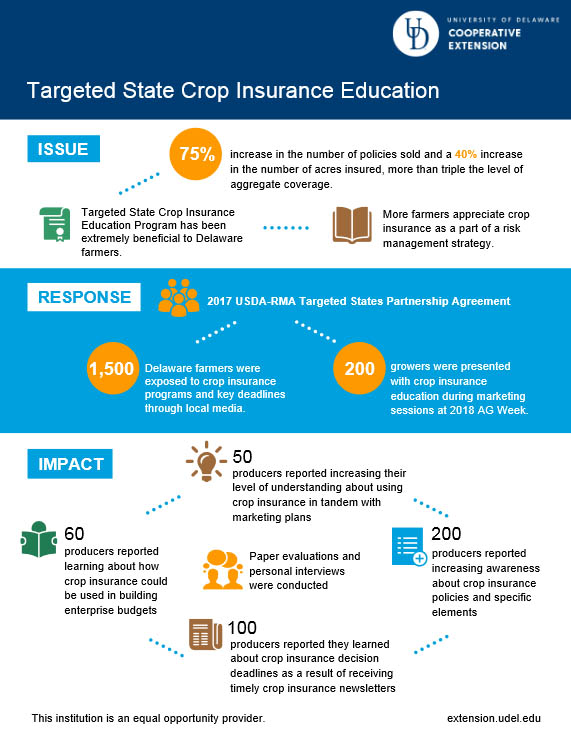
Targeted State Crop Insurance Education (2018)

ISSUE
According to the 2018 Kids Count Fact book, more than 16.6 percent of children under the age of 18 in Delaware are living in poverty. Statewide, this alarming statistic equates to more than 35,300 youth. Many of these disadvantaged youth have early exposure to risky behaviors that include substance abuse, poor diet practices, and lack a safe environment to build relationships with other youth and adults. The Afterschool Alliance reports youth are more likely to engage in risky behaviors during the hours of 3 to 6 p.m. when they are often unsupervised. Research has also demonstrated that youth today are under increasing pressure and stressors and often lack the ability to cope further placing them at risk for engagement in risky behaviors. According to Compas et al. (2017), stress is the single most potent risk factor for mental health problems facing today’s youth. O’Neil et al. (2014) reported this lack of ability to cope and increased stress also impacts food choices. It is estimated one out of three kids is overweight, and despite this most are malnourished, likely due to these poor food choices. The Oregon Community Foundation (2016) found students often also lack a sense of belonging and the ability to develop effective relationships with positive adult role models. A sense of belonging was long ago identified by Maslow (1968) as a basic human need. When this basic need is not met, students are at higher risk to engage in these risky behaviors.
RESPONSE
As a result of securing the 2017 USDA-RMA Targeted States Partnership Agreement, approximately 1,500 Delaware farmers were exposed to crop insurance programs and key deadlines through local industry media, both by paid advertising in the Delmarva Farmer as well as press releases. These farmers received information about crop insurance products and key deadlines through six direct mail newsletters, electronic news, and three to five postcard mailings. During 2018 Ag Week, crop insurance education was presented to over 200 growers during marketing sessions, and a similar topic presented at the Mid-Atlantic Women in Ag conference reached about 30 producers through an educational exhibit. A number of growers received educational handouts via an exhibit that was staffed at Delaware Ag Week (average 1,800 in attendance). It is estimated that over 200 young, beginning, and socially disadvantaged farmers attended a crop insurance education session during one of the many opportunities that were offered through University of Delaware’s programs, including the Beginning Farmer meetings, Mid-Atlantic Women in Ag Conference, and commodity association meetings, such as the Delmarva Poultry Industry, and Delaware Fruit and Vegetable Growers.
IMPACT
Paper evaluation and personal interviews were conducted in an attempt to capture the impacts of the crop insurance education offered during the past year. Fifty producers reported increasing their level of understanding about using crop insurance in tandem with their marketing plans. One hundred producers reported that they learned about crop insurance decision deadlines as a result of receiving timely crop insurance newsletters. Sixty producers reported learning about how crop insurance could be used in building enterprise budgets. Two hundred producers reported increasing awareness about crop insurance policies and specific elements.
